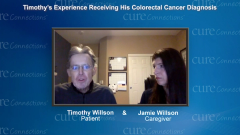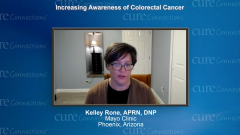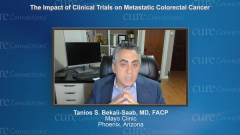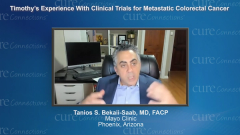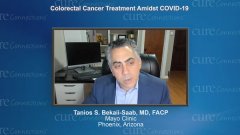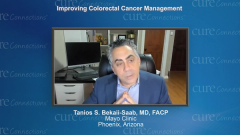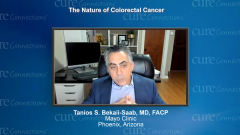
Typical Colorectal Cancer Diagnosis and Journey
Episodes in this series

Tanios S. Bekaii-Saab, MD, FACP: Your presentation is certainly not what we consider a standard presentation. Most folks present a bit later in their lives, and they usually have blood in the stools or changes in bowel movements. But occasionally this is the presentation. For you, it did not come with a warning sign. Oftentimes, it comes with a little warning sign, mostly a change in the color of the stools, blood in the stools, or some chronic pains.
Everything was done the way it usually is when we have someone presenting with an early stage colon cancer. We have to stage them with scans to ensure there is no cancer spread beyond that point. At the time you were diagnosed, there did not appear to be any cancer outside the confines of where the tumor was. The follow-up for a while will continue being with scanning and blood as was done in your case to make sure we do not miss emerging lesions. We know that the first two to three years of cancer, when it is diagnosed early enough for surgery, are critical. The first year is incredibly critical. The second is a bit less critical, but it is still there because the first two years are when you have the highest chance of the cancer coming back, and then it starts toning down after three years. Unfortunately, in your situation, the cancer decided it wanted to show back up. The phrase coming back is a bit misleading. That means it went away and came back. But it never left. It was just hiding as little cells in other areas, and it was not eradicated. We end up capturing it as we go through the scans as we did.
Kelley, I am going to go back to you on this. I know the role of nurse practitioners and advanced practitioners is better understood, but perhaps this is important: I can tell you, I cannot run a practice without Kelley. That goes without saying. Perhaps remind folks about what exactly your role is in guiding patients through diagnosis and treatment and talk about your first encounter with Tim.
Kelley Rone, APRN, DNP: My main role, at least the role I have now, is symptom management. If people are on therapy, chemotherapy or immunotherapy, I manage the side effects with the patients. I educate them about different medications they may need to use to manage symptoms or adverse effects of their therapy. I talk to them and educate them about what kind of things are going to happen when they start chemotherapy. I encourage people and help them through the process, whether it’s for adjuvant therapy, the post-chemotherapy following their surgery, or after they develop metastatic disease. I help them through the process because chemotherapy is hard. A lot of times, people need a lot of assistance and education as they go along. I was trying to think about the first time I met Tim. Correct me if I am wrong, but it was on the ReDOS trial, correct?
Timothy Willson: Yes.
Kelley Rone, APRN, DNP: Tim is not your usual patient on chemotherapy. Not much slows him down. He would usually know more about things than I did. A lot of times, he was educating me about things, which was quite nice. I was always chastising Tim. He would come in and complain about a side effect, and I would say to him, “It is because you are playing hockey four or five times a week. I cannot fix your problem because you insist on playing hockey.” I am pretty sure Jamie got mad at him because he spent a lot of money on some fancy ice skates to help his feet not hurt so bad from the treatment. My goal is to make people’s treatments better.
Tanios S. Bekaii-Saab, MD, FACP: You do a great job with that.
Timothy Willson: Absolutely.
Tanios S. Bekaii-Saab, MD, FACP: Kelley is humble. She does more than just symptom management. She is a full partner in this journey for every patient of ours, and I certainly rely and our patients rely quite a bit on her.
Transcript Edited for Clarity


